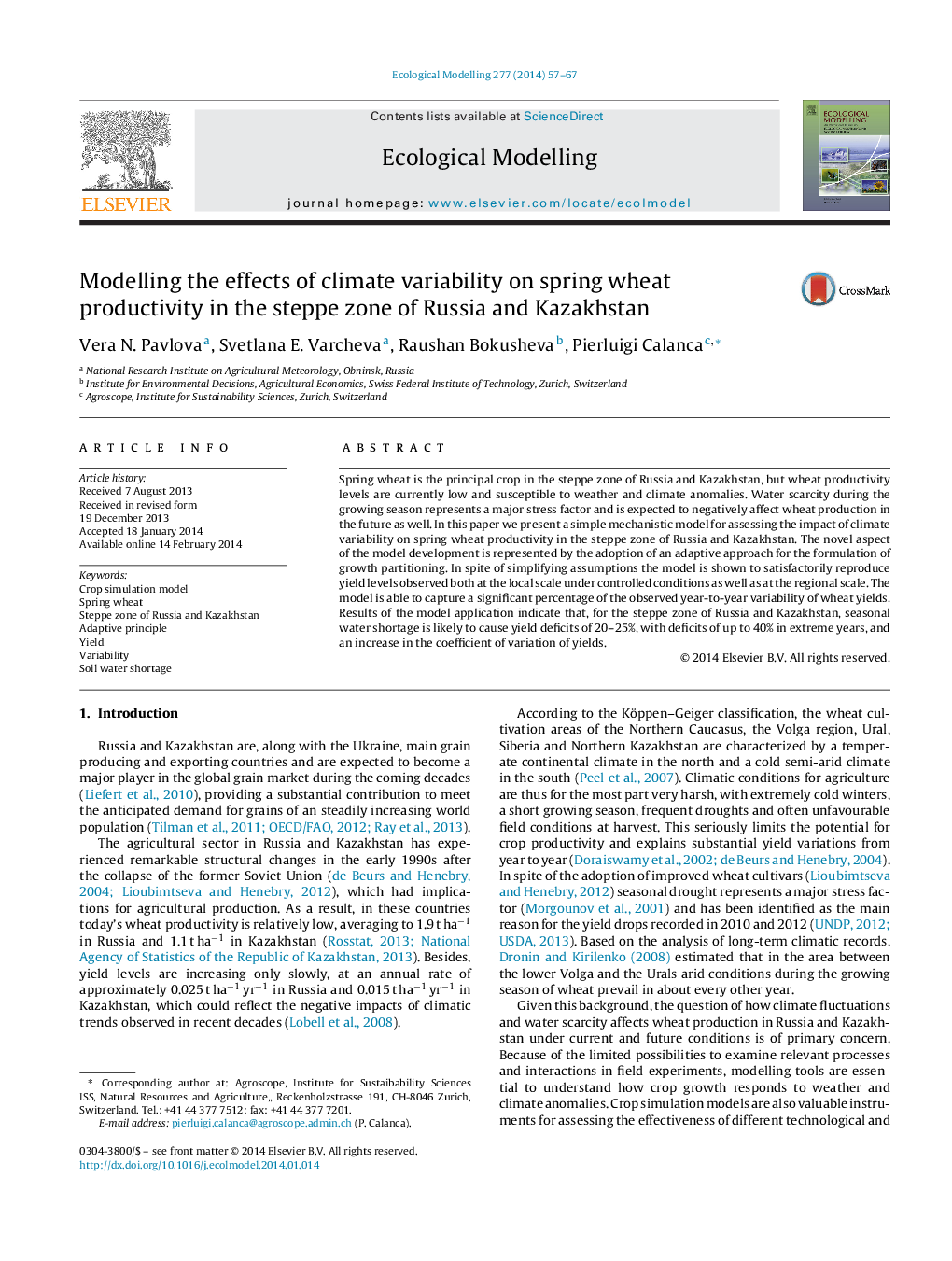| کد مقاله | کد نشریه | سال انتشار | مقاله انگلیسی | نسخه تمام متن |
|---|---|---|---|---|
| 4375986 | 1617469 | 2014 | 11 صفحه PDF | دانلود رایگان |
عنوان انگلیسی مقاله ISI
Modelling the effects of climate variability on spring wheat productivity in the steppe zone of Russia and Kazakhstan
ترجمه فارسی عنوان
مدل سازی اثرات تغییرات اقلیمی بر بهره وری گندم بهاره در منطقه استپ روسیه و قزاقستان
دانلود مقاله + سفارش ترجمه
دانلود مقاله ISI انگلیسی
رایگان برای ایرانیان
کلمات کلیدی
مدل شبیه سازی محصول، گندم بهار، منطقه استپ از روسیه و قزاقستان، اصل سازگار، بازده، تغییرپذیری، کمبود آب در زمین،
ترجمه چکیده
گندم بهاره محصول اصلی در منطقه استپ روسیه و قزاقستان است، اما سطح بهره وری گندم در حال حاضر کم و حساس به ناهنجاری های هوا و هوا است. کمبود آب در طول فصل رشد نشان دهنده یک عامل اصلی استرس است و انتظار می رود که در آینده نیز منجر به تولید گندم شود. در این مقاله ما یک مدل مکانیکی ساده برای ارزیابی تاثیر تغییرات اقلیمی بر بهره وری گندم بهاره در منطقه استپ روسیه و قزاقستان ارائه می کنیم. جنبه جدیدی از توسعه مدل، با پذیرش یک رویکرد انطباقی برای تشکیل پراکندگی رشد، بیان شده است. به رغم فرضیه های ساده، مدل نشان می دهد که سطوح عملکرد هر دو در مقیاس محلی تحت شرایط کنترل شده و همچنین در مقیاس منطقه ای، به خوبی ردیابی می شوند. این مدل قادر به جذب درصد قابل توجهی از تغییرات مشاهده شده از سالهای سال به تولید گندم است. نتایج برنامه کاربردی مدل نشان می دهد که برای منطقه استپ در روسیه و قزاقستان کمبود آب فصلی احتمالا سبب کمبود تولید در 25-25٪ می شود و با کمبود 40٪ در سال های شدید و افزایش ضریب تنوع عملکرد
موضوعات مرتبط
علوم زیستی و بیوفناوری
علوم کشاورزی و بیولوژیک
بوم شناسی، تکامل، رفتار و سامانه شناسی
چکیده انگلیسی
Spring wheat is the principal crop in the steppe zone of Russia and Kazakhstan, but wheat productivity levels are currently low and susceptible to weather and climate anomalies. Water scarcity during the growing season represents a major stress factor and is expected to negatively affect wheat production in the future as well. In this paper we present a simple mechanistic model for assessing the impact of climate variability on spring wheat productivity in the steppe zone of Russia and Kazakhstan. The novel aspect of the model development is represented by the adoption of an adaptive approach for the formulation of growth partitioning. In spite of simplifying assumptions the model is shown to satisfactorily reproduce yield levels observed both at the local scale under controlled conditions as well as at the regional scale. The model is able to capture a significant percentage of the observed year-to-year variability of wheat yields. Results of the model application indicate that, for the steppe zone of Russia and Kazakhstan, seasonal water shortage is likely to cause yield deficits of 20-25%, with deficits of up to 40% in extreme years, and an increase in the coefficient of variation of yields.
ناشر
Database: Elsevier - ScienceDirect (ساینس دایرکت)
Journal: Ecological Modelling - Volume 277, 10 April 2014, Pages 57-67
Journal: Ecological Modelling - Volume 277, 10 April 2014, Pages 57-67
نویسندگان
Vera N. Pavlova, Svetlana E. Varcheva, Raushan Bokusheva, Pierluigi Calanca,
